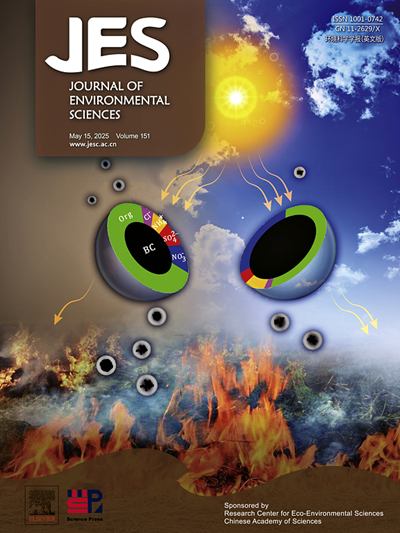紫外/小分子单羧酸体系生成二氧化碳阴离子自由基用于氯代烷烃还原脱氯
IF 6.3
2区 环境科学与生态学
Q1 ENVIRONMENTAL SCIENCES
引用次数: 0
摘要
由于氯代烷烃的生物毒性和高挥发性,其在水生环境中的持久性构成重大健康风险,从而造成水和空气污染。本研究考察了紫外照射下二氧化碳自由基阴离子(CO2•−)介导的高级还原过程(ARPs)在小分子单羧酸(SMAs)中对氯化烷烃的还原脱氯作用。通过对甲酸(HCOOH)、乙酸(CH3COOH)和丙酸(CH3CH2COOH)生成CO2•−的研究,揭示了UV/HCOOH体系在90 min内对氯仿(CF)的降解效率达到97.8%。动力学研究表明,HCOOH浓度与观察到的反应速率常数(kobs)呈线性关系,表明CO2•−的产生对CF的降解至关重要。电子顺磁共振波谱鉴定出CO2•−和羟基自由基(HO•)为活性自由基,前者在CF降解中起主导作用。该研究还探讨了SMAs中碳链长度对CF降解的影响,发现较长的碳链会降低降解效率,这可能是由于UV活化降低所致。在酸性条件下,反应速率常数(kobs)较高,当pH超过3.7时,反应效率显著降低,HCOO−占主导地位。本研究增强了我们对CO2•−介导的ARPs的理解,并探索了在环境修复中的潜在应用,为CF降解的途径和机制提供了见解。与传统方法相比,UV/ sma系统在实际应用中具有更温和的反应条件和更高的效率。本文章由计算机程序翻译,如有差异,请以英文原文为准。

Generation of carbon dioxide anion radical by UV/small molecular monocarboxylic acid system for reductive dechlorination of chlorinated alkanes
The persistence of chlorinated alkanes in aquatic environments poses significant health risks due to its biotoxicity and high volatility, which contributes to both water and air pollution. This study investigates the efficacy of carbon dioxide radical anion (CO2•−) mediated advanced reduction processes (ARPs) for the reductive dechlorination of chlorinated alkanes using small molecular monocarboxylic acids (SMAs) under UV irradiation. The study focused on formic acid (HCOOH), acetic acid (CH3COOH), and propionic acid (CH3CH2COOH) to generate CO2•−, revealing that UV/HCOOH system exhibits a notably high chloroform (CF) degradation efficiency of 97.8 % in 90 min. Kinetic studies indicated a linear relationship between the HCOOH concentrations and the observed reaction rate constants (kobs), demonstrating that CO2•− production is crucial for CF degradation. Electron paramagnetic resonance spectroscopy identified CO2•− and hydroxyl radicals (HO•) as the active species, with the former playing a predominant role in CF degradation. The study also explored the influence of carbon chain length in SMAs on CF degradation, finding that longer chains decrease the degradation efficiency, potentially due to reduced UV activation. A higher reaction rate constant (kobs) under acidic conditions, with a marked decrease in efficiency as the pH exceeds 3.7, where HCOO− becomes predominant. This study enhances our understanding of CO2•− mediated ARPs and explores potential applications in environmental remediation, providing insights into the pathways and mechanisms of CF degradation. The UV/SMAs systems offer advantages for practical applications, such as milder reaction conditions and higher efficiency compared to traditional methods.
求助全文
通过发布文献求助,成功后即可免费获取论文全文。
去求助
来源期刊

Journal of Environmental Sciences-china
环境科学-环境科学
CiteScore
13.70
自引率
0.00%
发文量
6354
审稿时长
2.6 months
期刊介绍:
The Journal of Environmental Sciences is an international journal started in 1989. The journal is devoted to publish original, peer-reviewed research papers on main aspects of environmental sciences, such as environmental chemistry, environmental biology, ecology, geosciences and environmental physics. Appropriate subjects include basic and applied research on atmospheric, terrestrial and aquatic environments, pollution control and abatement technology, conservation of natural resources, environmental health and toxicology. Announcements of international environmental science meetings and other recent information are also included.
 求助内容:
求助内容: 应助结果提醒方式:
应助结果提醒方式:


